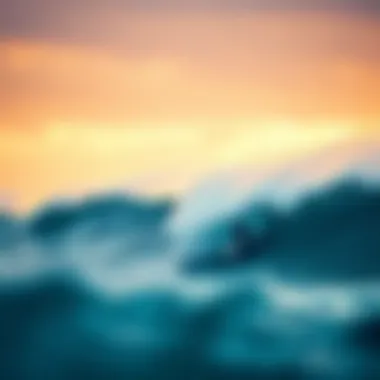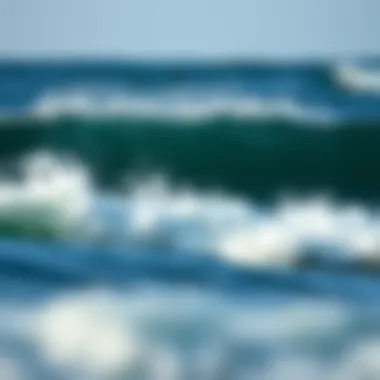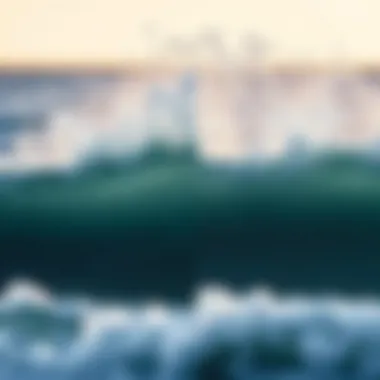Understanding Wind Patterns for Surfers' Success


Intro
Surfing, a dance with the ocean, draws on a myriad of elements, and one of the most pivotal among them is wind. It’s not just a gentle breeze; wind patterns can shape the very character of the waves that surfers ride. Understanding these wind patterns is crucial for surfboarders aspiring to refine their skills and elevate their surfing experiences.
Every surfer, whether a seasoned wave chaser or a newcomer eager to catch their first wave, stands to benefit from grasping how wind influences the ocean's surface. This guide seeks to illuminate the interaction between wind patterns and wave formation, exploring practical applications for surfers of all levels.
In the following sections, we will break down surf techniques tailored to different skill levels, delve into the essential gear every surfer should consider, and impart wisdom on wind forecasting to enhance your time in the water. Grab your board, and let’s ride the wind together.
Prelude to Wind Patterns
Wind patterns hold a pivotal role in the vast theater of surfing. They aren’t just weather quirks; they form the backbone of surf conditions, influencing wave formation and affecting experiences in the ocean. Understanding these delicate movements of air not only helps surfers select the best times and spots for their rides but also leads to improved outcomes for their overall surfing adventures.
Defining Wind Patterns
Wind patterns refer to the consistent directions in which the air moves across the Earth's surface. These patterns are formed by different factors, including geographical features, temperature differences, and the rotation of the Earth itself. To put it simply, wind patterns are like the unsung heroes of the ocean, quietly shaping conditions that surfers depend on heavily. An understanding of these directions helps surfers anticipate changes in the ocean's behavior, which can transform a mediocre session into an epic one.
There are various categories of wind patterns, from local flukes that change by the minute to established seasonal trends that dictate weather and wave shapes for months on end. For instance, during summer, coastal areas might experience “onshore” winds which can flatten the waves due to turbulent air blowing towards the shore. Conversely, “offshore” winds tend to create cleaner and more powerful waves by blowing away from the shore, setting the stage for a spectacular surf.
Importance of Wind in Surfing
It's no exaggeration to say that wind can make or break a surfing session. Consider the wave formation process where wind energy transfers into the water, resulting in the beautiful swells we aspire to ride. The nuances of wind direction, speed, and duration can alter wave height and shape, impacting both performance and safety in the water.
Surfers need to be alert to these changes, as calm days may not always yield the best waves. An understanding of wind is essential because it not only affects the quality of the waves but also informs surfers about how to position themselves in the water. Keeping track of wind patterns helps predict optimal conditions, assisting both seasoned and novice surfers alike. By honing one's wind-reading skills, surfers can navigate the ocean with a heightened sense of awareness, maximizing both thrill and enjoyment.
“The ocean is like a living creature, and the wind is its breath.” - A simple quote, yet it captures the essence of wind's significance in surfing.
Types of Wind Patterns
Understanding the various types of wind patterns is crucial for surfboarders looking to improve their skills on the water. Each type of wind influences wave formation and surfing conditions differently, giving surfers various factors to consider when selecting a surf spot. Knowledge of these patterns helps maximize wave quality and enhances overall surfing experiences. Here’s a deeper dive into the main types:
Local Winds
Local winds are generated by the unique geographic features of a region, like mountains or coastal formations. They tend to be short-lived but can significantly influence surf conditions. For instance, a land breeze forms during the night when the land cools faster than the water, which might flatten out waves but also bring clean conditions the next morning. Conversely, the sea breeze, common during the day, can create chop on the surface but also provide uplifting swells.
- Characteristics of Local Winds:
- Short-term effects on surf quality
- Can dramatically shift wave height and direction
- Often vary from day to day or even hour to hour
If you’re surfing a beach with pronounced local winds, knowing the typical patterns can give you an edge. Observing these winds can be likened to reading the tide, both are key components in optimizing your surf session.
Seasonal Wind Patterns
Seasonal wind patterns are dictated by broader climatic changes throughout the year. These winds can greatly impact the ocean's surface conditions, providing the right or wrong mix of waves depending on the season. For instance, winter often brings stronger storms and powerful swells, while summer might yield gentler winds with softer waves perfect for beginners.
- Examples of Seasonal Winds:
- Stronger offshore winds in winter
- Milder onshore winds in summer


These seasonal shifts can dictate whether you are paddling out for a mellow surf or preparing for a thrilling ride on hefty swells that can challenge even the most seasoned surfers. Understanding the seasonal dynamics helps in planning trips and maximizing surf time.
Trade Winds
Trade winds are a climactic constant, blowing primarily from east to west in tropical regions. They have been navigators' friends for centuries, providing steady offshore conditions ideal for wave building. For surfers, the trade winds often translate to consistent surf spots with ample opportunities for riding.
- Impact of Trade Winds on Surfing:
- Provide consistent wave pattern
- Contribute to forming major swell events
When the trade winds are blowing, surfers typically expect more favorable conditions, marked by an even spread of swell direction. Noticing how these winds shift can offer smarter picks for your surfing days and ultimately lead to more epic sessions.
Prevailing Winds
Prevailing winds are the ones that blow predominantly from a specific direction over a long period. Different regions have their own prevailing winds influenced by factors like geographic orientation and ocean currents. These winds can affect ocean temperature, resulting in either conducive or challenging surf conditions.
For example, if you are surfing on the West Coast of the United States, you might experience powerful westerly winds that generate robust swells for most of the year.
- Benefits of Understanding Prevailing Winds:
- Helps predict long-term surf conditions
- Key for establishing surf spots frequented by surfers
By knowing the prevailing wind patterns for your location, you can make informed decisions and capitalize on surf days when conditions align perfectly with your skill level and preferences.
Takeaway: Each type of wind pattern brings unique characteristics that can determine the quality of your surfing experience. Understanding these elements is not just advantageous but essential for making the most of your time in the water.
Impact of Wind Patterns on Waves
Understanding the interplay between wind patterns and waves is fundamental for anyone keen on achieving a better surfing experience. Waves are more than just a fun ride; they are a product of countless natural forces working in unison. Wind, in particular, plays a vital role in shaping wave characteristics such as height, direction, and quality. By comprehending how wind influences these elements, surfers can develop strategies to enhance their performance and enjoy superior surfing conditions.
Wave Formation Process
Waves originate from the wind's interaction with the surface of the ocean. When wind blows across the water, it transfers energy to the water's surface, generating ripples that can evolve into larger waves. This process begins with small oscillations, which can eventually grow significantly in size if conditions allow.
Key steps in wave formation include:
- Wind Speed: Stronger winds generate larger waves, as they impart more energy to the water.
- Fetch: This refers to the distance over which the wind blows across the water. A longer fetch allows waves to build more energy.
- Duration: The amount of time the wind blows in a single direction also affects wave size. Continuous wind leads to more powerful waves.
In a nutshell, when wind stirs the ocean, it sets off a cascade of energy that forms waves, each with its own unique characteristics, depending on these factors. This is why understanding the wave formation process is crucial for surfers; it allows them to predict when and where they can catch the best waves.
How Wind Affects Wave Height
The height of a wave is directly influenced by wind strength, duration, and fetch. Generally, the following points illustrate this relationship:
- Stronger Winds Produce Taller Waves: As the wind's strength increases, so does the height of the waves. A gentle breeze will create small, gentle swells, while a howling gale will lead to towering waves.
- Duration Matters: If the wind blows continuously for an extended period, the waves can accumulate energy and height. In contrast, short bursts of wind may only produce small, choppy waves.
- Fetch is Key: A limited fetch can restrict wave height, resulting in smaller, disorganized waves. Surfers often seek beaches where the fetch is unobstructed to experience waves with more potential height and energy.
Overall, surfboarders need to be mindful of wind conditions to gauge wave height before heading out. Knowledge of these principles can help surfers plan their sessions better by choosing optimal times to hit the water based on current wind patterns.


Wave Direction and Wind Influence
Wind doesn’t just influence the height of waves; it also impacts their direction. The direction in which waves break is a crucial factor for surfers, determining the best spots for riding and the overall surfing experience.
Here’s how wave direction is affected by wind:
- Onshore Winds: When the wind blows from the sea towards the shore, it often creates steeper waves that break closer to the beach. This can make waves more challenging but rewarding to surf.
- Offshore Winds: These winds blow from the land out to the ocean, usually smoothing out the waves, making them more predictable and easier to ride. Surfers often prefer this wind for ideal conditions.
- Cross-shore Winds: Winds blowing parallel to the coastline can create a mixed bag, with inconsistent wave directions that may lead to choppy conditions.
In summary, understanding wave direction in relation to wind patterns can significantly enhance a surfer's ability to read the ocean. By choosing the right wind conditions, surfboarders can not only improve their comfort but also their performance on the waves.
"Knowledge of how wind shapes waves is not just useful; it's essential for any surfer looking to elevate their game."
For further reading on wave dynamics and wind interactions, visit Britannica or explore this resource for community insights.
Reading Wind Patterns for Surfing
Understanding wind patterns is crucial for surfers as these natural forces directly influence the conditions they encounter on the water. By learning how to read these patterns, surfers can enhance their experience and maximize the quality of their rides. When you get a grip on wind patterns, you’d not only spot optimal surf days but also learn to adjust your strategy based on changing conditions.
Understanding Weather Reports
Weather reports are surfers' best friends, offering valuable insights into upcoming wind patterns. These reports provide information on wind speed, direction, and gale warnings that can significantly affect wave quality. Familiarizing yourself with these reports can give you a leg up before heading out.
- Wind Speed: Generally measured in knots, knowing whether the wind is light, moderate, or strong is essential for forecasting wave conditions. Surfers typically prefer offshore winds, which help form cleaner waves, while onshore winds can lead to choppy surf.
- Wind Direction: This is equally important. Knowing whether the wind is coming from the land (offshore) or the ocean (onshore) can turn a good surfing day into a great one. Offshore winds help create more organized waves, while onshore winds tend to make them messy.
- Weather Tools: Leverage local surf forecasts and surfing apps that provide updates in real-time. Sites like surfline.com or magicseaweed.com often have comprehensive wind and wave reports tailored for surfers of all kinds.
Knowing how to decipher what’s being said in these reports turns you into a savvy surfer. Even the fanciest board won't be much good if you hit the waves at the wrong time.
Tools for Wind Pattern Analysis
When it comes to analyzing wind patterns, using the right tools can make all the difference. A keen surfer doesn’t just rely on gut instinct; they harness technology and knowledge of various tools that can help in forecasting and evaluating conditions.
- Online Resources: Websites like windy.com offer detailed maps of wind patterns that are interactive, allowing surfers to visualize wind flow and direction across regions. This can help in planning trips to less popular, but more favorable surf spots.
- Apps for Wind Tracking: Many smartphones can access apps designed specifically for surfers. These apps provide updates on local surf conditions, wind patterns, tide charts, and more. Popular choices include Surfline and FishBrain. These tools often provide notifications for ideal surf conditions.
- Local Knowledge: Engaging with local surf communities, like visiting forums on reddit.com or joining local surfing clubs on social media, can help gather firsthand insights on unpredictable wind changes.
In summary, mastering the art of reading wind patterns combines the understanding gleaned from reports, with tools that can translate those insights into practical decision-making. Knowing when to hit the waves could be the key to catching that perfect ride.
Strategies for Utilizing Wind Patterns
Understanding wind patterns is not just a concept to grasp; it’s an essential toolkit for surfers who want to make the most of their time on the water. Wind influences wave formation, height, and direction, serving as a guiding force in choosing the perfect surf spot and adjusting techniques. This section aims to equip surfers with strategies to harness the knowledge of wind patterns to elevate their surfing experience.
Choosing the Right Surf Spot
When it comes to selecting a surf spot, wind patterns play a crucial role. Different locations respond uniquely to the winds, and familiarizing oneself with these subtleties can lead to discovering the best spots. Here are some key considerations:
- Local Geography: Understanding the coastline, reefs, and sandbars can help predict how the wind interacts with the waves. For instance, a spot that faces directly into prevailing winds might not be ideal, as the waves could become choppy rather than clean and surfable.
- Wind Strength and Direction: Ideal surfing conditions generally occur when winds are light and offshore. For example, the winds at beaches like Mavericks in California create a dynamic interplay thatforms powerful waves, creating prime conditions for advanced surfers.
- Timing: Winds change throughout the day. Morning or late afternoon might yield calmer conditions, allowing for smoother waves. Surfing spots vary with tides and seasons influenced by winds. Plan your sessions accordingly for maximum enjoyment.
"Good surfers learn the winds. Great surfers read the seas."
Breaking down the wind's influence can even allow surfers to become part of the local surf culture, showing respect for conditions and the sport itself. Not every day will be perfect, but knowing the local winds helps make informed choices, ensuring a more pleasant experience.


Adjusting Surfing Techniques Based on Wind
Once the right spot is chosen, adapting surfing approaches to wind conditions becomes paramount. Here’s how surfers can alter their techniques to make the most out of varying wind patterns:
- Body Positioning: When facing onshore winds, it’s vital to keep low. Squatting down helps reduce drag and maintain balance. Conversely, in offshore winds, a taller stance may give additional control over faster waves.
- Paddling Techniques: Against strong onshore winds, swift paddling can enhance the velocity needed to catch a wave. When the winds are in your favor, a relaxed paddling style may suffice, conserving energy while still allowing momentum.
- Wave Dynamics: Understanding how wind affects wave faces can shape rides. For instance, head-high waves with soften sloped faces due to offshore winds will require different maneuvers compared to choppy, steep waves from onshore winds. Sufer instincts kick in; correct timing in turns and jumps become vital in navigation.
- Adjust Routine: Just because a session started off as a smooth ride doesn’t mean it won’t change. Remain flexible in your approach. If winds shift unexpectedly, be ready to change speed or redirect your angle for optimal performance.
By melding the surf technique with environmental conditions, one can maximize surf sessions and minimize frustration. These adjustments make a world of difference, turning a windy day into a memorable surf adventure.
Forecasting Wind Patterns
Forecasting wind patterns is essential for surfers who wish to master the art of wave riding. The significance of this topic lays in its ability to enable surfers to predict upcoming conditions, thereby enhancing their time on the water. Understanding various forecasting methods can provide surfers with a better grasp of how to approach their surfing sessions and how to choose the best locations on any given day.
By predicting wind patterns, surfers can not only align their schedules with optimal conditions, but they can also refine their techniques and adapt their strategies accordingly. The variabilities brought forth by weather patterns can drastically impact the quality of the waves, suggesting the need to pay attention to subtle changes in currents and wind direction. An astute surfer is one who can seamlessly navigate these shifts by anticipating what lies ahead.
Short-term vs Long-term Forecasting
In the realm of surfing, forecasts can be categorized into short-term and long-term predictions. Short-term forecasts are invaluable for day-to-day surfing plans. These typically provide insight into conditions just one to three days out and can often change rapidly, as the atmosphere is influenced by unpredictable factors. Weather services deliver these updates using local meteorological data, satellite imagery, and sometimes, crowdsourced reports. Surf zones can experience sudden weather changes which short-term forecasts can effectively capture.
On the other hand, long-term forecasting looks into patterns that might span weeks or months. While such forecasts are generally less precise, they help surfers understand seasonal trends and help them plan trips around prime surfing seasons. Surfers can gauge what months usually bring consistent wind patterns and how that might align with their surfing goals. For example, during summer, regular southwesterly winds in California might create consistent swells, making it a favorable time for surfers heading to the coast.
"Being prepared for wind changes not only enhances your surfing but also improves safety in the ocean."
Utilizing Technology for Predictions
As technology advances, so do the tools available for wind pattern forecasting. Some software and apps have emerged, tailor-made for those who love to ride the waves. Platforms like Windy or Surfline utilize real-time data for precise local forecasts, giving surfers a clearer picture of what to expect. This data often includes wind speeds, direction, and even how these winds affect wave height in specific locations.
Additionally, satellite technologies have revolutionized the accuracy of forecasts. With predictive weather models utilizing artificial intelligence, it’s now possible to analyze huge sets of data and deliver forecasts with remarkable detail.
Tools such as buoy data and oceanographic models provide surfers with insight into wave energy, swell direction, and even tide schedules—factors critical in making informed decisions about when and where to surf.
The integration of technology into wave forecasting means that surfers can make informed choices with greater confidence than ever before, helping them catch that perfect wave. Some respected sources to consider include:
By harnessing these resources, surfboarders can elevate their performance and enjoy their time on the water even more.
Closure and Final Thoughts
Wind patterns play a crucial role in determining the quality of surfing conditions. From the way waves are shaped to how surfers must adapt their techniques, understanding the intricacies of these currents can significantly enhance one's experience on the water.
Recap of Key Points
- Wind Patterns Matter: They dictate how waves form and how they break. Knowing local winds, seasonal shifts, and persistent trade winds helps surfers pick the best times to ride.
- Impact on Waves: Wind not only affects wave height but also direction. An understanding of this can lead to better surf sessions.
- Adapting Techniques: As surfing conditions change due to winds, surfers must be agile—both in thought and action—to adjust accordingly.
- Forecasting and Technology: Using tools and weather forecasts can give surfers the upper hand. Monitoring conditions can mean the difference between a good day and a great day surfing.
- Continuous Learning: The ocean is ever-changing, and staying informed is key. Surfers should be open to learning from nature as well as from one another.
Encouragement for Continuous Learning
Surfing is not just a sport; it is a lifelong journey of discovery. As waves rise and fall, so too should the commitment to learning. Embracing a mindset focused on growth equips surfers to face challenges head-on.
Seek resources, such as surf forums and online courses, to deepen your understanding. Engaging with fellow surfers can provide real-world insights that no article can capture. Explore platforms like Reddit, where enthusiasts share experiences, swap tips, and inspire one another to innovate on the waves.
The learning does not stop at understanding wind patterns. It expands to technique and physical fitness, oceanography, and even environmental issues affecting our treasured surf spots.
Ultimately, the more you know about wind and waves, the more you can ensure that each surfing session is rewarding and enjoyable. Remember, the ocean is a vast class, and it’s up to each surfer to take their education into their own hands.















